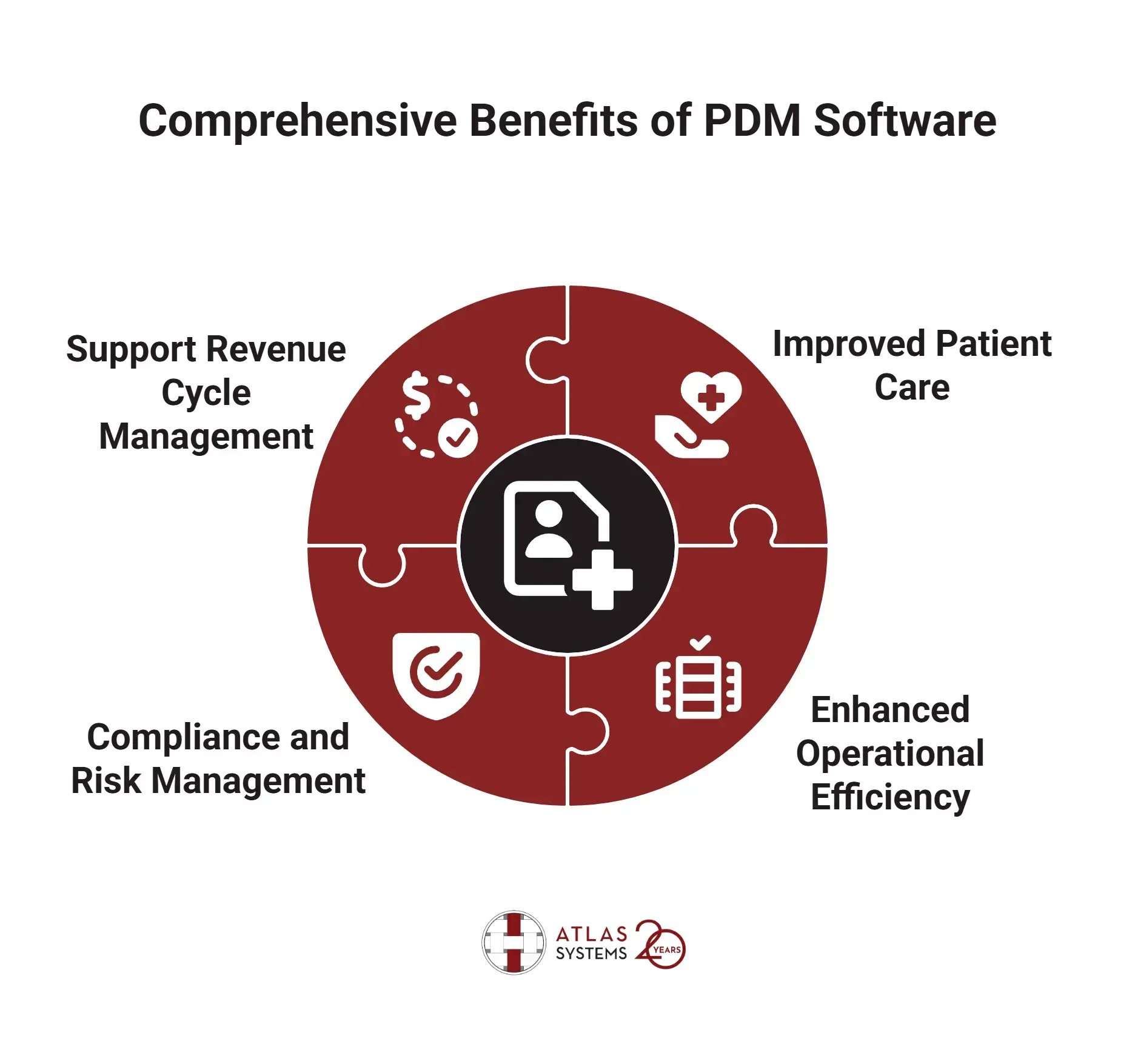Atlas Systems Named a Representative Vendor in 2025 Gartner® Market Guide for TPRM Technology Solutions → Read More
Key features
- First-person data validation: PRIME rigorously validates provider data by contacting health systems and providers to confirm critical data, such as specialties, locations, and languages spoken. This ensures high data quality.
- Self-service portal: Providers can easily verify and update their data on the portal, minimizing the administrative burden.
- AI-powered: "Ask PRIME," the platform’s AI-powered feature, allows users to research trends, get instant data insights, and other relevant information for better decision-making.
- FHIR compatibility: The software seamlessly exchanges provider data with other systems via the Fast Healthcare Interoperability Resources (FHIR) standard.
- Data enrichment: Enriches provider data by adding missing information, such as specialty codes, NPI numbers, and affiliations.
Pros
- High data accuracy rate: PRIME has a 95% success rate in accurately verifying and updating provider information through direct outreach, significantly improving healthcare directories' reliability.
- Improved patient experience: The software contributes to a better patient experience by helping patients easily find accurate and up-to-date information about providers.
- Compliance monitoring: By standardizing provider data through FHIR compliance and enabling real-time updates, Atlas PRIME helps organizations avoid costly fines and penalties associated with non-compliance.
- Quick implementation: A streamlined implementation process, FHIR compatibility, and a user-friendly dashboard facilitate data onboarding and management, minimizing the initial setup time.
- User-friendly interface: Healthcare payers can easily manage data thanks to the intuitive dashboard and self-service portal.
Cons
- Learning curve for advanced features: While the platform is generally user-friendly, some advanced features may require training for optimal use.
2. Availity Essentials
Availity provider data management software streamlines healthcare providers' clinical, financial, and administrative data. It’s a centralized platform for checking patient eligibility, submitting claims, collecting payments, and managing prior authorizations.
Key features
- Eligibility verification: Healthcare payers avoffer real-time member eligibility and benefits information, reducing the chances of claim denials.
- Claims management: Payers use the platform to provide detailed payment information, updates on claim status, and to handle disputes and appeals.
- Streamlined payment collection: The integrated payment processing feature makes collecting patient payments easy.
Pros
- Automated processes: These streamline patient registration and claims management and improve data accuracy.
- Interactive Care Reviewer (ICR) feature saves time: Providers can submit clinical information and prior authorization requests online without making phone calls.
- Multi-payer access reduces the administrative burden: Providers can check patient eligibility and submit claims for different health plans (both national and regional).
- User-friendly interface: The platform is easy to use, and new hires can be onboarded quickly.
Cons
- Occasional outages: During downtimes, users must revert to manual verification methods.
- Heavily relies on insurance company data: The PDM tool uses data provided by insurance companies, and inconsistencies can affect claim processing.
- Restricted information access: Limited access to certain information hinders financial planning.
3. CredentialStream by HealthStream
This platform automates the process of credentialing and privileging. Healthcare payers use it to streamline their credentialing processes, leading to quicker reimbursements and improved patient safety. The patented Privilege Solution automates the online review of providers and the evaluation of qualifications.
Key Features
- Centralized platform: Provider information, such as licenses and certifications, is stored in a secure, centralized location.
- Powerful analytics: Analytics tools provide insights into provider performance, enrollment efficiency, network management, and more to help payers make informed decisions.
- Provider lifecycle management: Modules for different stages of the provider lifecycle cover all provider management aspects.
Pros
- The Evaluate module helps with assessing clinical performance: The module’s reporting capabilities and defined metrics help healthcare payers comply with regulatory requirements.
- Tracking KPIs is sasy: Reporting and analytics features enable payers to track key performance indicators (KPIs) and spot areas for improvement.
- Powerful integrations: CredentialStream integrates with other healthcare systems, such as Electronic Health Records (EHRs), providing a centralized approach to managing enrollment, credentialing, and privileging.
- Automated workflows: Automated credentialing and privileging tasks significantly reduce administrative work, minimizing errors and improving efficiency.
Cons
- Steep learning curve: Some users have reported that the software can be complex to learn and use and initially requires significant training and support.
- Occasional performance issues: During peak usage, the system can become slow and impact productivity. Frequent updates also affect the performance of verification plug-ins and some processes.
- Customization issues: It can be difficult to customize workflows, and some customization options are limited.
4. symplr Provider (formerly Cactus Software)
Health insurance companies use this provider data management tool to manage the complex process of verifying and onboarding providers. It streamlines the credentialing process, boosting operational efficiency and ensuring compliance.
Key features
- Automated provider onboarding: Symplr Provider automates the onboarding process for new providers, minimizing manual data entry and speeding up the credentialing process.
- Reporting and analytics: These features enable healthcare payers to track credentialing status and compliance metrics and create detailed reports for regulatory compliance and audits.
- Real-time data access: The software gives real-time access to provider data for faster decision-making and enhanced credentialing.
Pros
- Workflow automation: The tool automates most manual credentialing tasks, such as background checks, application processing, and primary source verification.
- Customizable reports: Health insurance companies can create reports to meet specific audit and compliance requirements.
- Enhanced compliance tracking: The system sends automated reminders for compliance requirements and license renewals to ensure all providers maintain their qualifications.
- Comprehensive solution: The platform streamlines all provider management processes, from onboarding to performance evaluation.
Cons
- Complex reports: While users can customize reports, some say it takes time to pull data efficiently and generate specific reports.
- Learning curve: Using the system can be complex initially, and substantial training is needed for optimal use.
- Occasional performance issues: Some users report experiencing system slowdowns during peak usage times.
5. NewgenONE
This PDM software is designed to help healthcare payers maintain accurate information about providers to streamline onboarding and credentialing processes. The companies maintain an organized directory of providers, comply with regulatory requirements, and improve the overall patient experience. NewgenONE utilizes features like data cleansing, validation, and integration.
Key features
- Robust integrations: NewgenONE integrates with popular medical applications and claims systems to validate data against key sources like license websites and SAM.GOV.
- Variance screening: The platform creates variance reports for providers who fail crucial integration checks so that payers can initiate cases for review.
- Artificial intelligence/machine learning features: The platform uses AI/ML for document classification, data extraction, and risk assessment.
Pros
- Real-time data validation: Health insurance companies can validate provider data against sources such as Medicaid state files to maintain up-to-date and accurate information.
- Comprehensive reporting tools: These give deeper insights into provider performance and compliance metrics, supporting informed decision-making.
- Mobile access: Users can access and update provider information using mobile devices.
- Compliance support: Automated data validation and reporting features help payers maintain compliance with regulatory requirements.
Cons
- Limited training resources: Some users need more structured training materials to maximize the platform's capabilities.
- Limited customizations: While the platform is flexible, some users find it hard to customize workflows to fit their unique organizational needs fully.
- Learning curve: Using the system initially can be difficult and time-consuming due to its complexity.
6. Medallion
This provider data management platform has comprehensive credentialing, licensing, and enrollment tools for managing provider networks. It offers a centralized hub for all provider data and allows for efficient management and regulatory compliance.
Key features
- Enrollment automation: Automated data collection, verification, application submission, and follow-up streamline the enrollment of healthcare providers.
- Compliance tools support audits: The platform’s compliance tools ensure payers remain audit-ready by keeping accurate provider records and documentation.
- Seamless integrations: Medallion integrates with popular healthcare systems and third-party databases for streamlined data validation and enhanced operational efficiency.
Pros
- Real-time monitoring: Medallion continuously monitors provider licenses and certifications to ensure compliance with regulatory requirements.
- Automated workflows: Critical processes such as onboarding, credentialing, and monitoring are automated for operational efficiency.
- Customized reports: The Report Builder module lets users build, schedule, and export custom reports. It gives insights into provider performance and operational metrics.
Cons
- Occasional integration challenges: Some users report issues when integrating the software with certain systems or pulling large amounts of data from CAQH.
- Self-service limitations: Organizations managing their enrollments report limited self-service options.
- Redundant document listings: Unnecessary document listings make it hard for users to find specific data.
7. Verisys
This provider data management platform helps payers collect, organize, verify, and manage provider data from different sources. They maintain accurate and up-to-date information on provider credentials, licenses, and compliance status for credentialing and patient safety purposes. The comprehensive database helps with monitoring changes and flagging potential issues.
Key features
- Automated credentialing: The credentialing process is automated, minimizing the administrative burden and streamlining provider onboarding.
- Compliance monitoring: Verisys has tools for continuous compliance monitoring, which help healthcare payers adhere to regulatory requirements and avoid penalties.
- Seamless integrations: Verisys integrates with popular healthcare systems such as Practice Management Systems (PMS) and Electronic Health Records (EHR) for quick data exchange.
Pros
- Real-time data validation: Features for real-time data validation ensure provider information is always accurate and reliable.
- Provider screening: Thorough provider screening processes ensure compliance and protect payers from reputational damage, financial loss, and regulatory risks.
- Customizable directories: Users can customize the searchable provider listings by configuring data fields like specialty, provider tiers, network, and location.
- Robust reporting tools: These allow payers to generate detailed reports on healthcare provider data to monitor data accuracy and maintain regulatory compliance.
Cons
- Advanced features are complex: While Verisys has a user-friendly interface, some advanced features require additional training for full utilization.
- Vendor lock-in: Some users have reported difficulty switching to a different provider data management solution.
- Heavy dependence on data sources: The external sources integrated into the system dictate the accuracy of provider data.
8. LexisNexis VerifyHCP
LexisNexis VerifyHCP helps healthcare payers manage and validate provider data to maintain accurate information about their providers. Automated checks and outreach methods streamline data verification, ensuring access to reliable information and compliance with regulatory requirements. The software is developed in collaboration with the American Medical Association (AMA).
Key features
- Data cleansing: The software cleanses and enriches provider data using advanced algorithms to ensure accuracy and completeness.
- Automated provider data validation: The real-time provider information search service gives payers an efficient means to research new providers, health systems, and affiliations.
- Compliance management: VerifyHCP helps payers comply with federal and state regulations for directory accuracy and avoid penalties.
Pros
- Real-time updates: Real-time monitoring and updating of provider data ensures that provider directories reflect the most current data.
- Multi-channel outreach: The platform confirms and updates provider information through various outreach methods (calls, email, fax) for timely responses.
- Machine learning: Machine learning helps maintain data accuracy and optimizes data insights.
- User-friendly: VerifyHCP has a user-friendly interface that allows healthcare payers to manage their directory information efficiently.
Cons
- Vendor lock-in: Switching to a different provider data management solution can be difficult.
- Limited customizations: Users have reported customization limitations for certain aspects of the software.
- Training requirements for advanced features: Some features may require additional training for effective utilization.
9. Coperor E-MDM
Designed specifically for the healthcare industry, Coperor E-MDM helps payers manage and maintain accurate provider data across all systems. It creates a centralized database for provider information. Healthcare payers use it to manage provider data like credentials, practice locations, demographics, and affiliations.
Key features
- Low-code integration: Users can update data with minimal coding, easily integrating it with existing systems.
- Data governance: Tools for effective data governance enhance data accuracy and security and ensure compliance with regulations such as GDPR and HIPAA.
- Change Data Capture (CDC) feature: The feature captures changes in the source data in real-time, keeping information accurate for better decision-making.
Pros
- Data cleansing: Coperor E-MDM fixes common inaccuracies in source data, like misspellings and typos, for high-quality data management.
- Seamless data integration: The software integrates various data sources seamlessly to provide a complete view of healthcare data.
- Scalable: The tool can handle large volumes of data and adapt to growing health insurance companies, allowing them to manage data effectively as their needs change.
- Real-time data propagation: There is minimal delay in transferring data, which allows for near-immediate access to updated data.
Cons
- Dependent on input data: Since the platform relies heavily on input data, inaccurate data can cause issues in the system.
- Initial setup is complex: Some users report challenges when integrating multiple data sources during initial setup.
- Steep learning curve for advanced features: Some advanced features may require training for full utilization.
Once you've reviewed the top platforms, read our comprehensive guide on choosing a provider data management software to learn how to evaluate these solutions against your specific requirements. We break down integration architecture, automation depth, and when standard platforms hit their limits.
FAQs About Provider Data Management Software
1. How Does Provider Data Management Software Improve Data Accuracy?
The software improves provider data accuracy by centralizing and standardizing provider information across systems, enabling real-time updates, enforcing data validation rules, and providing tools for identifying and correcting inconsistencies. Provider details stay consistent across the healthcare ecosystem.
2. Can provider data management software integrate with other healthcare systems?
Yes, PDM software can integrate with other healthcare systems such as Electronic Health Records (EHRs), Payer Networks, Practice Management Software, and Credentialing Verification Organizations (CVOs).
3. How does provider data management software help with provider credentialing?
The software centralizes provider information across healthcare systems for streamlined data collection and easy verification of credentials, speeding up the provider credentialing process and minimizing administrative burdens.
4. Can provider data management software handle large volumes of data?
Yes, the software is designed to handle large volumes of data. It utilizes cloud-based storage and scalable architecture to allow for the integration and management of extensive provider information from multiple sources.
5. How does provider data management software help with data duplication?
PDM software prevents data duplication by utilizing features like data cleansing, deduplication algorithms, and matching rules to identify and eliminate redundant records.
6. What is the cost of provider data management software?
The cost of provider data management software depends on its features, the size of the organization, and its specific needs. Generally, prices range from $500 to $10,000 per month (for larger healthcare payers with complex needs). Some PDM software vendors offer tiered pricing plans.
.png?width=869&height=597&name=image%20(5).png)

.png?width=300&height=175&name=Rectangle%2034624433%20(2).png)












.png?width=645&height=667&name=Widgets%20(2).png)














.png)



.webp)






